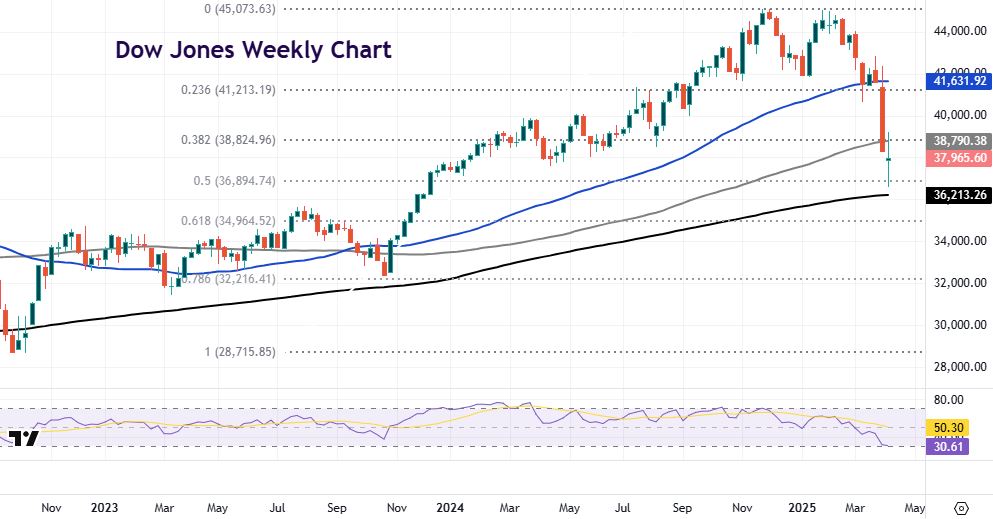Crazy price action as markets try to make sense of trade war

- Dow, S&P 500 both end wild session modestly lower, Nasdaq in the green
- The VIX, the volatility gauge, closed at 46 after topping 60 intraday
- Dollar rebounds with US Treasury yields as bonds sell off
- Trump threatens extra 50% tariff on China, opens doors to talks
FX: USD rose for a second straight day as US yields surged after a tumultuous day. We heard from various members of the Trump administration over the weekend. We think it’s worth quoting what the Treasury Secretary Bessent said as he echoed other comments that “the market is not the economy” and he didn’t expect a recession in the US this year, while suggesting that lower interest rates and energy prices were good news. There was much headline noise during the day (see Stocks Comments below). A Fed official said how inflation is the more pressing issue for the central bank.
EUR jumped to 1.1049 before sliding through the day. The EU said it is open to talks but will not wait endlessly. German industrial production contracted and is likely to get worse given fiscal spending is months away and tariffs are incoming. Sentiment continues to dominate as markets focus on trade tensions and assess the risks and implications of retaliatory measures.
GBP collapsed to one-month lows and was the worst performing major versus USD. Cable broke down through support around 1.2866 and below the 200-day SMA at 1.2811. Rate expectations have ramped up recently, as the UK levels up with policy easing similar to its peers. Markets have moved to price in a full quarter point move at the BoE May meeting. Next support is around 1.2622/28.
USD/JPY eventually moved higher after starting the day near recent lows around 145. Treasury yields moved north with the 10-year dipping to 3.88% before closing at 4.20% – a huge move in pips. BoJ hikes were priced out on a weakening domestic economy due to US tariffs. A call did take place between Trump and PM Ishiba, but a deal remains to be seen.
AUD got hit again after its huge down day last Friday. The aussie is a proxy for China and global growth and its cyclical nature is impacting heavily at present. There is little support below, other than the pandemic spike low at 0.5506. CAD was remarkably stable on the day as it traded back in its long held range from 1.42 to 1.45.
US stocks: The S&P 500 lost 0.23% to settle at 5,062. The tech-laden Nasdaq finished up 0.19% at 17,630. The Dow closed 0.91% lower at 37,965.
- The S&P 500 has now seen the biggest three-day decline (-10.73%) since 18 March 2020. The benchmark index is off 17.6% since its record high of 6,144 made in mid-February, though prices did drop into bear market territory (-20% from its high) intraday.
- US markets experienced wild price action in an unforgettable day of volatility. At one point during just 15 minutes of trading, the S&P 500 saw $2.5 trillion of gains come and go.
- Markets contended with conflicting news headlines – from Trump saying there would be no change in tariff policy to kick off the week, to the ‘fake news’ 90-day delay headline to Trump threatening an additional 50% tariff on China if they do not remove the 34% reciprocal levy by tomorrow.
- Communication services and tech were the only sectors in the green with real estate, materials and utilities were the biggest laggards. Apple plans to send more iPhones to the US from India to offset the high cost of China tariffs, according to media reports. A leading Tesla analyst cut his price target by 43% (from $550 to $315), due to a “brand crisis” driven by CEO Musk and Trump’s trade policies.
Asian stocks: Futures are in the red. Except for 1987, APAC stocks suffered their biggest market loss ever as last week’s selling continued as the trade war and growth concerns upset investor sentiment. Chinese markets collapsed following the extended weekend and Beijing’s tariff retaliation.
- The ASX 200 sunk amid losses across all sectors, with energy and mining stocks the worst hit owing to demand and growth-related concerns.
- The Nikkei 225 slumped after circuit breakers were triggered heading into the Tokyo open with too many sell orders. The index was slightly off today’s worst levels amid currency moves and currently trades near the August 2024 spike low at 31,156.
- The Hang Seng and Shanghai Comp were hit on return from the long weekend with the former suffering double-digit losses as participants reacted to Beijing’s retaliation against Trump’s reciprocal tariffs of 34% on all US goods from 10 April. Tech and financials suffered including HSBC (-13%) and Standard Chartered (-16%).
Gold sold off sharply for a second day after Thursday’s record high at $3167. As we have said before, liquidating to meet margin calls elsewhere is the likely reason for the dip as investors have to deleverage and pay for losses on other investments. Some of the tariff-fear premium was also likely unwound as bullion avoided any trade tariffs. We note there was a bid at the start of the day on news that China had added to its gold reserves for a fifth straight month.
Day Ahead – Volatile trade to continue
We hit huge fear mode in the Asian session, with markets and investors liquidating amid forced selling. There was massive uncertainty about after negative weekend news, with “headline havoc” also at very high levels. Any announcements around talks, delays or retaliation are being seized upon but can be denied in minutes and price action swiftly reversed. As we said in our Week Ahead, it’s important to remember in times like this that oversold and overbought can also mean very little as price action extend way beyond what we think is possible.
Risk-off means the yen and swissie should continue to perform well, while AUD, NZD and GBP go south and get sold. Other risky assets like stocks will struggle. But this all reverses if we get more positive headlines and we did see some bargain hunting towards the end of the session. As always, we recommend using strong risk management as there are lots of opportunities out there, but don’t get too greedy. Certainly in stock markets, valuations are now more sensible, so we have been looking at selective buying of beaten down sectors, especially in Europe. Today, we will be on the lookout for both China’s response to Trump’s threat and if deals between the US and other countries start to get made ahead of Wednesday’s reciprocal tariffs.
Chart of the Day – Did we hit Trump’s “pain point”?
We wrote in our Week Ahead how we thought there could be a certain point in the stock market rout when the Trump administration says they need to act. Of course, that would never be admitted and pressure on the Fed to cut rates is also never going to happen. We hit a 20% correction in the benchmark S&P 500 intraday, having also gone beyond that in the growth-heavy Nasdaq index. The former also bounced off major support.
For the Dow, the spike low from yesterday was 36,611, roughly 18.7% off the record high. It tapped the midpoint of the bull move from the October 2022 lows to the all-time top at 36,894. The 200-week SMA is at 36,210. The next upside level is the 100-day SMA at 38,785 and the 38.2% retrace Fib level at 38,824. We are only modestly oversold, but that doesn’t mean too much in this environment.

